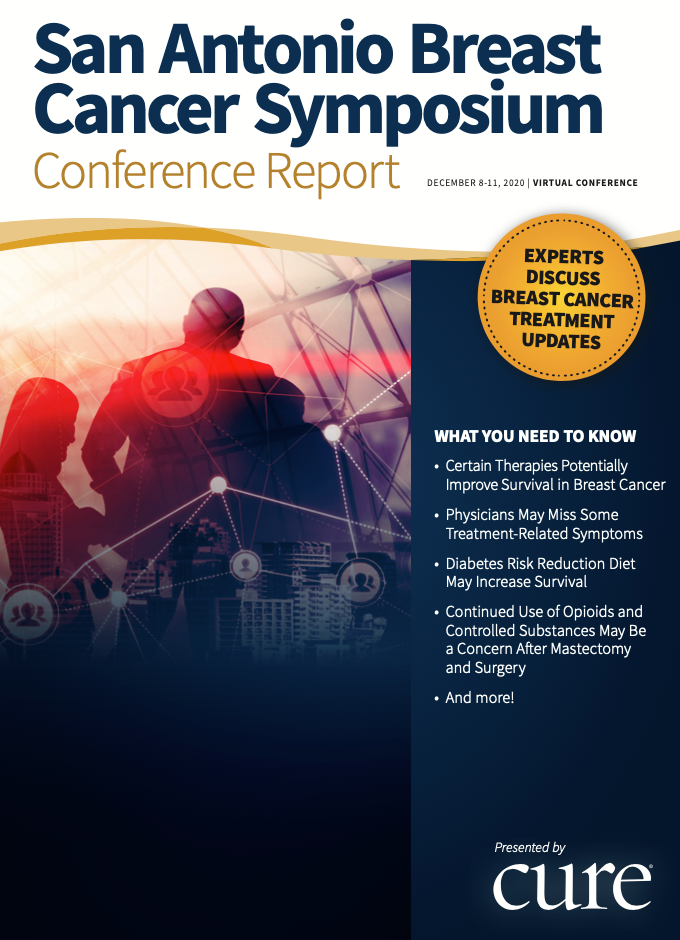Publication
Article
CURE
Chemotherapy With Endocrine Therapy Shows Clinical Benefit With Improved Survival in Breast Cancer
Author(s):
Premenopausal women with HR-positive, HER2-negative, lymph node-positive breast cancer and a risk for recurrence experienced benefits with chemotherapy plus endocrine therapy, with improvements in five-year invasive disease-free and overall survival.
Clinical benefit from the addition of chemotherapy to endocrine therapy may be determined by menopause status in women with hormone receptor (HR)-positive, HER2-negative, lymph node-positive breast cancer and a recurrence score between 0 and 25, according to findings from an analysis of the phase 3 RxPONDER trial that were presented virtually during the 2020 San Antonio Breast Cancer Symposium.
In particular, the addition of chemotherapy to endocrine therapy led to an improvement in five-year invasive disease-free survival and overall survival (OS) in premenopausal but not postmenopausal women.
In premenopausal patients, the five-year invasive disease-free survival rate was 94.2% in the chemotherapy/endocrine therapy arm vs. 89% in the endocrine-alone arm. In postmenopausal patients, the five-year invasive disease-free survival rate was 91.6% and 91.9%, respectively.
“Postmenopausal women with one to three positive nodes and recurrence score between 0 and 25 can likely safely forego adjuvant chemotherapy without compromising (invasive disease-free survival),” said lead study author Dr. Kevin Kalinsky during a press briefing.
“This will save tens of thousands of women the time, expense and potentially harmful side effects that can be associated with chemotherapy infusions,” Kalinsky, director of the Glenn Family Breast Center and Breast Medical Oncology at Winship Cancer Institute, added. “(However,) premenopausal women with positive nodes and recurrence scores between 0 and 25 likely significantly benefit from chemotherapy.”
Patients with HR-positive, HER2-negative, lymph node-positive breast cancer have an increased risk for recurrence and are typically treated with chemotherapy.
To prevent potential overtreatment or undertreatment, the 21-gene Oncotype Dx Recurrence Score is used to identify which patients with lymph node-negative, HR-positive, HER2-negative disease can omit chemotherapy.
In lymph node-negative patients, exploratory findings from the phase 3 TAILORx trial suggested that women over the age of 50 with a recurrence score of 25 or less derive no benefit from chemotherapy, whereas patients age 50 or under with a recurrence score between 16 and 25 may derive benefit from chemotherapy. However, whether these results were generalizable to the approximately 20% of patients with nonmetastatic HR-positive, HER2-negative disease and one to three positive lymph nodes in the United States had not been previously defined.
To that end, investigators launched RxPONDER, in which 5,015 patients with a recurrence score between 0 and 25 were randomized to endocrine therapy alone or chemotherapy followed by endocrine therapy. Patients with a recurrence score of more than 25 were treated with chemotherapy followed by endocrine therapy.
Patients in the randomized portion of the trial were categorized by recurrence score (0-13 versus 14-25), menopausal status (pre versus post), and nodal surgery (axillary lymph node dissection versus sentinel lymph node biopsy).
Eligible patients included females 18 years of age or older with at least 1% estrogen receptor and/or progesterone receptor expression, HER2 negativity, one to three positive lymph nodes, recurrence scores of 25 or less without distant metastases and an ability to receive taxane and/or anthracycline-based chemotherapy.
Invasive disease-free survival, defined as local, regional, distant recurrence, any second invasive cancer or death due to any cause, served as the primary end point of the study. OS served as the secondary end point.
Additional results demonstrated that the invasive disease-free survival benefit also translated into an OS benefit in premenopausal patients. In this population, the five-year OS rate was 98.6% with chemotherapy/endocrine therapy vs 97.3% with endocrine therapy alone. However, in postmenopausal women, the five-year OS rate was 96.2% and 96.1%, respectively.
Providing additional perspective during the press briefing, SABCS co-director, Dr. C. Kent Osborne, founding director of the Dan L. Duncan Comprehensive Cancer Center and Dudley and Tina Sharp Chair for Cancer Research at Baylor College of Medicine, said, “The results clearly show no benefit to adding chemotherapy to standard endocrine therapy in postmenopausal patients, despite having positive nodes, emphasizing that node positivity, while an important prognostic marker, is not a predictive marker of chemotherapy sensitivity.”
“In premenopausal patients, a different result was obtained. Is the difference in outcome in this subset due to the endocrine effects of chemotherapy? Unfortunately, we may never know the answer to this question,” Osborne concluded.
For more news on cancer updates, research and education, don’t forget to subscribe to CURE®’s newsletters here.





